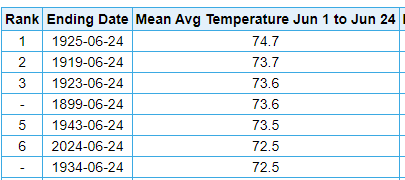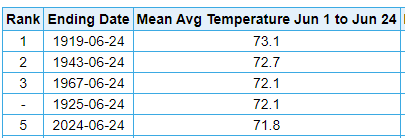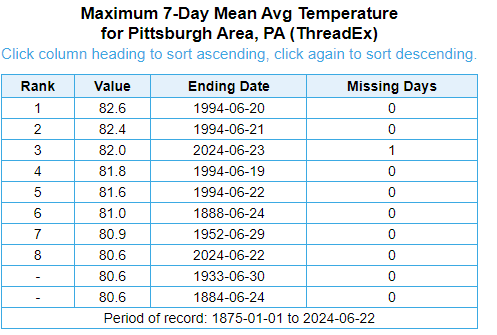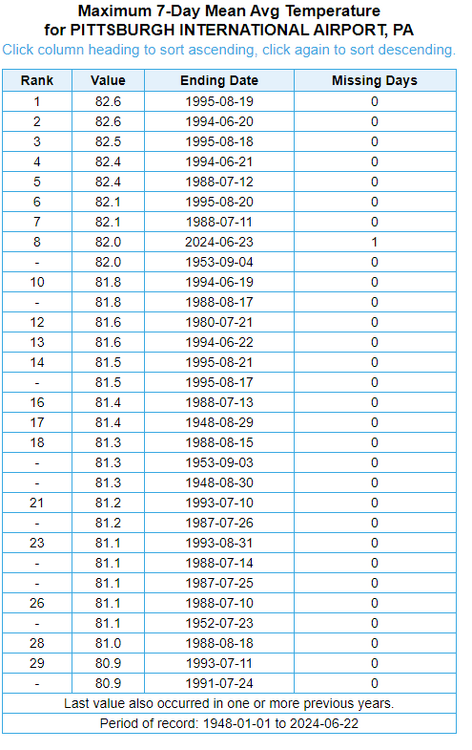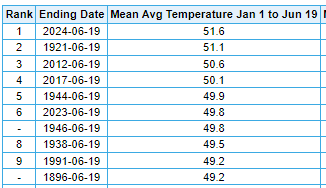
TheClimateChanger
Members-
Posts
4,155 -
Joined
-
Last visited
Content Type
Profiles
Blogs
Forums
American Weather
Media Demo
Store
Gallery
Everything posted by TheClimateChanger
-
Occasional Thoughts on Climate Change
TheClimateChanger replied to donsutherland1's topic in Climate Change
-
Central Pa. Summer 2024
TheClimateChanger replied to mahantango#1's topic in Upstate New York/Pennsylvania
Very solid numbers statewide, with many locations in the midst of their warmest June in many decades. Harrisburg [3rd warmest to date, warmest since 1943] Williamsport [6th warmest to date, warmest since 1943] Hagerstown, Maryland [just over the border] [3rd warmest to date] Bradford [shorter POR - 1958] [warmest to date] Dubois [shorter POR - 1963] [2nd warmest to date, behind 1967] Scranton/Wilkes-Barre Area [5th warmest, warmest since 1967]- 6,666 replies
-
Central Pa. Summer 2024
TheClimateChanger replied to mahantango#1's topic in Upstate New York/Pennsylvania
I guess it depends on the level of rarity you wish to achieve. There have been 13 of those at MDT since 2000 - or a little more frequent than once every other year. 5 days of 90+ would be a little more than once every year. But either is better than the traditional 3 days of 90+.- 6,666 replies
-
Central Pa. Summer 2024
TheClimateChanger replied to mahantango#1's topic in Upstate New York/Pennsylvania
There's a fine line between rare and climatologically impossible.- 6,666 replies
-
Central Pa. Summer 2024
TheClimateChanger replied to mahantango#1's topic in Upstate New York/Pennsylvania
IMO, the 3-day threshold is more appropriate for places like Pittsburgh, Cleveland, Detroit, Buffalo, Albany, Boston, etc. Not sure why it became the standard in Harrisburg.- 6,666 replies
-
Central Pa. Summer 2024
TheClimateChanger replied to mahantango#1's topic in Upstate New York/Pennsylvania
The 3-day definition was never intended for very hot climates like Harrisburg. Pittsburgh has had 26 stretches of 3 or more 90F readings in a row since 2000 - an average of about once per year. When people think of a heat wave, they think of a period of heat that is expected to occur about once a year more or less. Harrisburg, on the other hand, has had 75 stretches of 3 or more 90F readings since 2000 - an average of about 3 per year. To get it to that once per year sweet spot, you should be using 5+ days of 90F or more. There have been 28 of those, or just a little more than once per year.- 6,666 replies
-
Central Pa. Summer 2024
TheClimateChanger replied to mahantango#1's topic in Upstate New York/Pennsylvania
Nobody uses that definition, nor should they. You realize there are only 6 overnight lows of 80F+ in Harrisburg weather history? None on back-to-back nights.- 6,666 replies
-
Pittsburgh, Pa Summer 2024 Thread.
TheClimateChanger replied to meatwad's topic in Upstate New York/Pennsylvania
Well, Mark Margavage says unlikely, but I'm not too convinced by the logic employed to reach that conclusion. I did a little more analysis, looking at years with similar or warmer Junes over the past 100 years or so [excluding any 19th century records]. Specifically, I looked at 1919, 1925, 1934 (downtown city office), 1943 (AGC), and 1967 & 1994 (PIT). You could make the case for 1988 - it had 8 90+ days in June - but it was characteristically different than the other years. In fact, it was decidedly cooler than the present normal for June and nearly 4F cooler than this year on a to-date basis. So despite the periods of extreme heat, it wasn't a particularly warm month overall. Obviously, 1988 would somewhat buck the trends presented and instead look like a more extreme version of 1934 that carried straight through August. Overall, the historical data following very warm Junes would, in fact, suggest the worst is probably over. 1919 & 1934 both saw one impressive heat wave in July. There were four days of 90+ in a row from 7/2/1919 to 7/5/1919, and 7 of 8 in 1934 from the 19th to 26th. That was regarded as one of the worst heat waves ever for much of the country with widespread 100s, but downtown Pittsburgh topped off at 98 on the 24th, and in classic fashion, had an 89 right in the middle disrupt what could have been an 8-day heat wave. Overall, July looked fairly typical other than 1934. The city office means and maximum temperatures from that era are no doubt elevated relative to what would be observed at the airport locations. August was decidedly cooler than modern normals, with no extreme heat in any of the months. In fact, only 4 days of 90+ spread across the 6 years [and only 1 day that actually exceeded the 90 degree mark]. In any event, historically, very warm Junes in Pittsburgh have not served as a prelude to a non-stop blazing inferno the rest of the summer. In fact, the majority of years, temperatures were relatively moderate, with at most one more stretch of extreme heat seen. -
June 16th-21st (and beyond?) Heatwave
TheClimateChanger replied to Geoboy645's topic in Lakes/Ohio Valley
Thanks for the update. -
Pittsburgh, Pa Summer 2024 Thread.
TheClimateChanger replied to meatwad's topic in Upstate New York/Pennsylvania
Using the entire threaded record (1875-2024), including the downtown city office records, and the expected value of 81.4F, this will be the hottest 7-day period ever wholly in June behind only 1994 (7-days ending 6-19, 6-20, 6-21, and 6-22). While the magnitude might have been exaggerated, and this might be an unpopular opinion, the NWS did correctly indicate that this would be the hottest stretch in June since 1994 [although it clearly did not exceed 1994, even though they distinctly indicated that was a possibility]. And they made that forecast with several days lead time. Actually, from the above graphic, you can see the 7-day period ending yesterday already on this list with a mean 80.6F, which alone makes it the highest in the month of June behind only the 4 dates from 1994, and one week each in 1888 and 1952 [and tied with the week ending 6/30/1933 & 6/24/1884]. As noted, the 7-day period ending today should be even higher and likely finish around 81.4F. -
Pittsburgh, Pa Summer 2024 Thread.
TheClimateChanger replied to meatwad's topic in Upstate New York/Pennsylvania
Say what you will about the heat wave underperformance but the most recent 7 days will indeed be the hottest 7-day stretch [as measured by average mean temperature] in 29 years at Pittsburgh International Airport. Indeed, the hottest 7-day period since the ASOS has been installed. A lot of these are duplicates, i.e. longer single hot stretches that had multiple different 7-day periods. For context, the 82.0F mean only includes 6 days. But today's high was 86, low so far 75. Estimating the low will drop to 70F by 1 am, we get 82.0 x 6 + 78 = 570 / 7 = 81.4F. Not sure how plausible it is that we had stretches on this list from 1987, 1988, 1991, 1993, 1994 and 1995 in a narrow 10-year window with a known warm biased thermometer, but I'll leave that conspiracy hat off for now. The 1948 & 1952 periods are actually from AGC, even though incorrectly included in this dataset. The only other comparable 7-day means at Pittsburgh International (not in the aforementioned 10-year period) are the 7-days ending 7/21/1980 & 9/3/1953. -
Pittsburgh, Pa Summer 2024 Thread.
TheClimateChanger replied to meatwad's topic in Upstate New York/Pennsylvania
80 degrees already. -
Central Pa. Summer 2024
TheClimateChanger replied to mahantango#1's topic in Upstate New York/Pennsylvania
000SXUS71 KPBZ 222127RERDUJRECORD EVENT REPORTNATIONAL WEATHER SERVICE PITTSBURGH PA0525 PM EDT SAT JUN 22 2024...RECORD HIGH TEMPERATURE SET AT DUBOIS PA...A RECORD HIGH TEMPERATURE OF 92 DEGREES WAS SET AT DUBOIS PA TODAY.THIS BREAKS THE OLD RECORD OF 91 DEGREES SET IN 2022. THIS ALSO TIES THE ALL-TIME TEMPERATURE RECORD FOR JUNE.$$MILCAREK- 6,666 replies
-
Central Pa. Summer 2024
TheClimateChanger replied to mahantango#1's topic in Upstate New York/Pennsylvania
Wow! Generational heat in Chester!- 6,666 replies
-
- 1
-

-
Central Pa. Summer 2024
TheClimateChanger replied to mahantango#1's topic in Upstate New York/Pennsylvania
000SXUS71 KCTP 212125RERIPTRECORD EVENT REPORTNATIONAL WEATHER SERVICE STATE COLLEGE PA0523 PM EDT FRI JUN 21 2024...RECORD HIGH TEMPERATURE SET AT WILLIAMSPORT PA...A RECORD HIGH TEMPERATURE OF 98 DEGREES WAS SET AT WILLIAMSPORT PATODAY. THIS BREAKS THE OLD RECORD OF 97 DEGREES SET IN 1923.- 6,666 replies
-
- 1
-

-
Pittsburgh, Pa Summer 2024 Thread.
TheClimateChanger replied to meatwad's topic in Upstate New York/Pennsylvania
-
Pittsburgh, Pa Summer 2024 Thread.
TheClimateChanger replied to meatwad's topic in Upstate New York/Pennsylvania
-
Central Pa. Summer 2024
TheClimateChanger replied to mahantango#1's topic in Upstate New York/Pennsylvania
That 57 near East Berlin (Brrr-Lin) looking mighty nice right about now.- 6,666 replies
-
- 1
-

-
Pittsburgh, Pa Summer 2024 Thread.
TheClimateChanger replied to meatwad's topic in Upstate New York/Pennsylvania
Dewpoint has dropped back into the comfortable 50s. -
Pittsburgh, Pa Summer 2024 Thread.
TheClimateChanger replied to meatwad's topic in Upstate New York/Pennsylvania
Record high of 90F at DuBois - likely to rise higher. That's the fifth consecutive daily record. Even for a relatively small period, very impressive. Good chance of matching or exceeding the monthly record of 92F, set on June 30, 1969, and earlier in this heat stretch (June 18, 2024). That's also 4 90+ readings on the year. For context, only 6 entire years since 1962 have seen more 90+ days, and this is only June 21! Those 6 years are: 1988, with 20; 2020 & 1966, with 8 each; 2010, with 6; and 2016 & 2011, with 5 each. Odd how 1800' elevation is obliterating records from 1988 & 1994, but they claim it was so much hotter in Pittsburgh. Like they are going to toe to toe with the 1994 heat episode, and breaking records set during that stretch by noon every day. Seems strange to me. -
Central Pa. Summer 2024
TheClimateChanger replied to mahantango#1's topic in Upstate New York/Pennsylvania
Record high of 90F at DuBois. That's the fifth consecutive daily record. Even for a relatively small period, very impressive. Good chance of matching or exceeding the monthly record of 92F, set on June 30, 1969, and earlier in this heat stretch (June 18, 2024). That's also 4 90+ readings on the year. For context, only 6 entire years since 1962 have seen more 90+ days, and this is only June 21! Those 6 years are: 1988, with 20; 2020 & 1966, with 8 each; 2010, with 6; and 2016 & 2011, with 5 each.- 6,666 replies
-
Pittsburgh, Pa Summer 2024 Thread.
TheClimateChanger replied to meatwad's topic in Upstate New York/Pennsylvania
Baking today. PIT ASOS popping an 88F at 10:25. -
Central Pa. Summer 2024
TheClimateChanger replied to mahantango#1's topic in Upstate New York/Pennsylvania
Just checked MDT and it's the same story.- 6,666 replies
-
Central Pa. Summer 2024
TheClimateChanger replied to mahantango#1's topic in Upstate New York/Pennsylvania
Yeah, I haven't noticed this phenomenon. At PIT, highs are actually more above normal than lows so far this month, with the diurnal range near 21F. I'm sure rural and outlying areas probably have diurnal ranges on the order of 22-24F this month.- 6,666 replies
-
While the thread creator suggesting sticking a fork in the month of June, Dayton International Airport observed its 4th consecutive 90+ reading today [coming off an 89F on Sunday]. The forecast calls for 90+ through Sunday, which, if it were to occur, would be the most 90F readings through June 23rd in any year since 1994. In addition, Dayton continues to impress from a temperature standpoint in 2024. The mean temperature through yesterday stood at 51.6F (and rapidly climbing each day of this heat wave). This is more than 0.5F warmer the second warmest year (2012). Of course, it's worth pointing out that the official observation site was still in the city, which can be as much as 300 feet lower in elevation than the airport, and with a significant urban heat island effect exacerbated by poor siting of the instrument on a building rooftop. Thus, it's likely that 2012 is actually the second warmest, but I digress. Between 1872 & 1996, 15 years at Knoxville saw mean temperatures [through 6-19] equal to or colder than Dayton in the year of our lord 2024. An additional 8 years in that interval were within 0.5F of the Dayton value. Whereas previously Dayton was performing better against Oklahoma City, the very hot summer climate of Oklahoma City is starting to leave Dayton in the dust. However, there were 6 years between 1899 & 1979 that were less than or equal to 51.6F [including one year (1979) that was a whopping 2F colder]. A total of 16 years in that same time interval are no more than 0.5F warmer than 2024 in Dayton. Based on this data, we can conclude that Dayton in 2024 is warmer than 1 out of every 8 years observed in Knoxville during the 19th and 20th century. We can similarly conclude that Dayton is warmer than about 1 in every 13 years in OKC during the first 4/5ths of the 20th century. Although this doesn't tell the full story, since Dayton is relatively warmer in the wintertime and OKC racks up massive numbers in the summertime. As such, it's very unfair to just look straight up since Dayton has a much milder climate overall than OKC.



